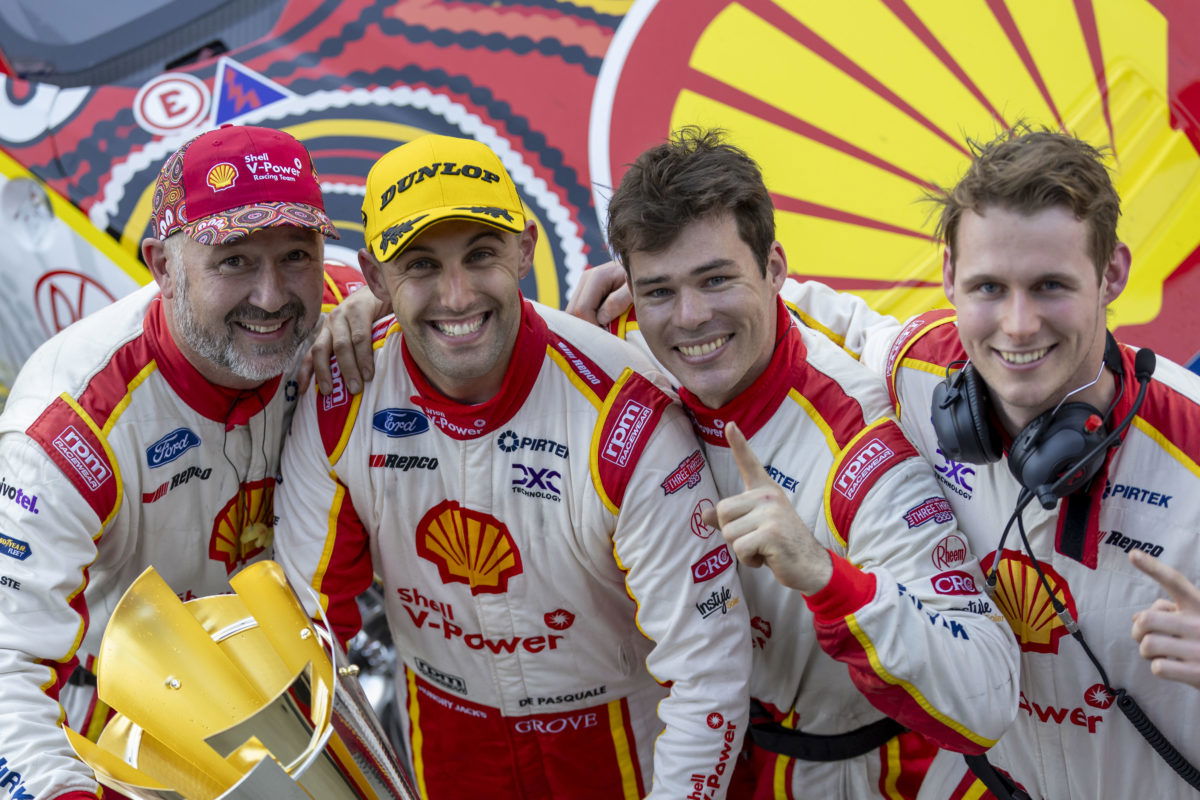

The category needed a Ford win and it duly got one with a superbly executed strategy from Anton de Pasquale and Ludo Lacroix on Sunday.
I’ve been amazed so far this year that ADP hasn’t been the lead Ford, given that he does have a very good engineer and he can drive … but they’ve finally put it together. Better late than never.
There’s no question that the two of them went into the race almost certainly locked into a three stopper. Anton used the tyre hard in the early laps and, in doing so, he pushed several other runners into pushing too hard with tyres that were going to have to last longer. But he knew he was coming in early, so he was happy to push the tyre.
Meanwhile, the increasingly mature Brodie Kostecki sat back, mindful of the probability at that moment of a two stopper being likely, and never dipped into the 1.15s thereby ensuring that his last lap before his first stop was a 1.18 dead, whilst Will Brown, on the same lap did a 1:18.7.
And in the last stint, Brodie again never dipped below 1.16, whereas Andre Heimgartner did a 1:15.4 on his first flying lap of that stint and subsequently was half a second a lap slower than Kostecki by lap 85. No surprise that Brodie passed him for second.
There’s only so much life in a new tyre and if you use it too hard it simply won’t last as many laps. This, combined with overheating the surface if you slide the tyre, means that everyone, Camaro or Mustang, has to judge how to use the tyre over a stint.
ADP used the clean air to great effect and drove an extremely disciplined race, but he also showed that the Mustang is now definitely capable of being set up properly to race at least as well as the Camaro.
If anyone doubts that, then look at the lap times and performance of Thomas Randle. His last stint was as good as anyone except ADP and Brodie, plus he was fighting his way through from thirteenth to eighth.
Meanwhile, there were examples of driver after driver taking too much energy from the tyre too early and/or overheating it.
Drivers simply cannot ‘rag’ the car the way that Mostert did late in the race on Saturday and expect the tyre to hang in there, whether you’re driving a Camaro or a Mustang. Watching Chaz slide his car around was a great spectacle, but he was always going to run out of tyre before he could pass Broc Feeney as he was so aggressive on the tyre.
As I’ve said before, only Supercars have all the data to be able to truly make a judgement on parity. Hopefully they’ve landed in a good spot now. But I hear the chants of inexperienced team owners talking about there still being a parity issue despite qualifying at Townsville clearly showing that it was pretty equal at that venue.
Keeping the tyre on the car during a stint is down to the driver and engineer to work out now. The variance within both Ford and Chevrolet teams up and down pit lane, let alone team to team, is huge. Anton (not forgetting Thomas Randle as well) showed everyone how to do it on Sunday, as both Erebus and Triple Eight have done up to now.
But, as I’ve pointed out previously, the real issue is a tyre that isn’t good enough. I for one, don’t find it terribly interesting watching both F1 and Supercars drivers driving around the circuit to ‘a number’ as they all invariably do when they are trying to preserve tyres from overheating. The best race lap times are miles off what is achieved in qualifying – in the case of Supercars at Townsville, almost three seconds off, very appreciable over a 75-second lap. Stint averages are five seconds away from an ultimate lap!
Meanwhile, the delta between the best qualifying lap and the best race lap in the Porsche Carrera Cup round last weekend was 0.7 of a second, and that lap was set halfway through a 27-lap race with plenty of fuel on board! That shows me what is possible.
Give the drivers a tyre that can be lent on hard, with the potential to quickly recover from high temperature inputs, and we will all be able to watch better racing.
Being critical of the tyre is frowned upon in both F1 and Supercars, but the truth is that, in both places, most drivers and teams don’t have a high opinion of the respective products. Commercial considerations unfortunately tend to keep everyone from saying what they really think.
The powers that be have decided that tyre degradation is the key to good racing. But I don’t see a lot of evidence to support that. Let’s have a better tyre, less of them, and get back to genuine flat out racing rather than this driving to “a number” mentality.
In the meantime, the parity debate whines on.
By all means, go to a wind tunnel with both cars. But be very careful what you wish for … the results might not be what some folks want to hear.
After all, the last VCAT was performed at the request of Ford, but it ended up with the Camaro getting an increase in downforce.
One driver commented that the wing on his Supercar didn’t work as well as on a TCR car he’d driven. Fantastic! It isn’t meant to. TCR cars have too much downforce.
For the good of the category, let’s park the parity stuff right now. I’ll lead! No more parity talk.
Instead, let’s get the tyre sorted for next year so that the drivers can race harder and longer. If Supercars put the same amount of energy into dealing with that as they have with the P word, then they’ll nail it for 2024.




















Discussion about this post